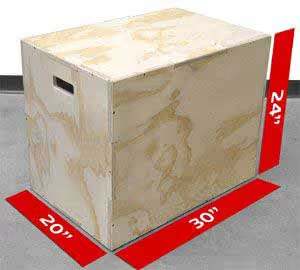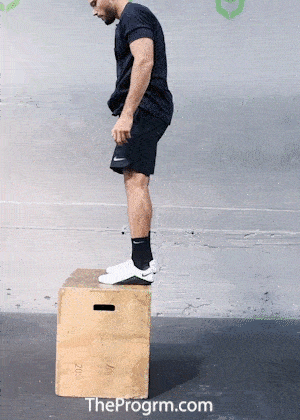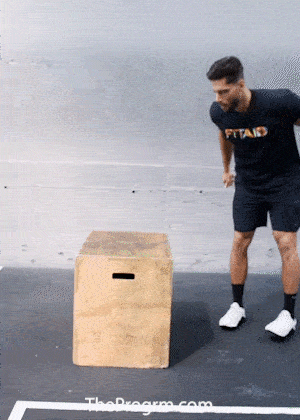The ultimate guide to mastering the box jump
In this blog post you will learn: What qualifies as a box jump in Crossfit and how to perform it properly. Technical details that will help you understand the



In this blog post you will learn: What qualifies as a box jump in Crossfit and how to perform it properly. Technical details that will help you understand the


In this blog post you will learn:
A box jump is a plyometric exercise where essentially an athlete starts facing a box 30-50cm away from it. He then jumps explosively onto said box, which is usually between 50 to 70cm in height.
Plyometric exercises, commonly referred to as plyometrics or plyos, are exercises that require muscles to exert maximum force. They are used in athletic training to increase power ( = speed x strength ) for sports that require short bouts of high intensity output such as gymnastics or sprinting. Conceptually they teach the body to rapidly extend and contract the muscle fibers.
In Crossfit they are used in a slightly different key as they are programmed usually for a higher number of reps requiring the athlete to become more efficient at moving and therefore conserving energy.
The true star of the box jump is your posterior chain: mainly glutes and hamstrings.
This said it also heavily relies on a strong and active core to ensure you’re not “soft” upon landing which could lead to no reps, or worse injury.
Lastly, in particular the rebounding box jump, they require explosive calf muscles and stable ankles ( = lots of work for the often overlooked ankle and feet stabilizers).

Essentially the athlete starts facing the box at about 30 to 50cm distance.
Usually the box is made of wood, or some type of covered sturdy foam, and between 50 to 70cm in height.
The athlete “loads” the jump by performing a quarter squat and bringing his arms slightly behind his frontal (coronal) plane.

He then extends his knees and hips while swinging his arms forward. By doing so he’s utilizing the built up momentum to propel himself upward and slightly forward, as he lifts in the air he will bend his knees and hips again in order to land on top of the box.
When landing, by allowing himself to keep descending ever so slightly in that quarter to half squat position, he will ensure he’s not excessively loading the joints by shifting the blunt force of the landing from his joints to his muscles.
He will then rise up from this semi squatting position and completely extend both hips and knees. Once both joints are locked out the rep is complete.
The athlete can then choose if to step down or jump down from the box.
In Crossfit using a box with standardized measurements is mandatory to complete RX workouts.
The box is a rectangular with 50 x 60 x 75 cm sides which equals to 20 x 24 x 30 inches. Women complete standard workouts with the box reaching the 50cm height, while men utilize the 60cm. Some workouts will have athletes scale up in height to 60 and 70cm respectively.

If you are just starting off and your gym provides boxes at a lower height feel free to start with those before scaling up.
The goal with this exercise is not only to be explosive in your jump but to learn how to quickly bring your knees up to your chest.
The movement is simple you load the jump by bending ever so slightly at the kips and knees, then jump up and vertical bringing your knees toward your chest.
When you’re quick to bring up your lower body you are essentially making the exercise slightly easier on your legs as you don’t have to jump as high to ensure you will land properly on the box.
Quick sets of 3-5 reps will help get your nervous system firing and ready to attack the box jump.
Although this isn’t truly a drill, it goes without saying you don’t need to jump ( hehe ) straight into a “full height” box jump.
It can actually be very helpful to scale up to it gradually by using lower boxes or stacking up some plates, especially if you’re new to the movement or are a bit afraid of it.
Rebound box jumps are a MUST if you want to compete in Crossfit because they increase your rep cycling speed.
A single box jump can’t qualify as a rebound box jump because the differentiating factor is in the rep to rep transition.
The athlete jumps off the box and lands in a slightly bent position similarly to how he catches the landing on top of the box.
By doing so he decelerates the landing and simultaneously starts loading for the next rep as he quickly springs back up into another jump.

This variation does have a slightly higher risk factor compared to “step down” box jumps because they require the athlete to absorb the landing “shock”.
Drills
Start with a 5kg (or “skinny”) plate and then progress to “fatter”/taller ones.
The goal is to start understanding the dynamics of the rebound. In sets of 10/20 practice jumping off the plate and back on.
You’re essentially mimicking the rebound box jump but at a much lower height.
Start standing on top of the box, heels off the border and weight supported in the front of your foot.
Jump off the box and upon touching the ground jump straight up ( NOTE:do not jump back onto the box but simply upwards, the goal is to land in the same spot you took off).
Make sure your knees don’t cave in upon landing or jumping.
This drill will allow you to get more comfortable with the “drop” that comes with jumping off a box. It will help you to activate your nervous system so you can efficiently catch the rebound and be explosive in the jump.
If you’re a rookie to box jumps and especially this variation it’s also a great way to get in some jumping volume without taxing the system as much as with full box jumps.
Also very common in Crossfit programming is the box jump over.
Different event rulebooks will have different standards on how to perform the movement.
Some may require the athlete to always be facing the box when starting a rep while others will allow the athlete to face it sideways, perpendicular to the box.
Another request to pay attention to is if the athlete must lock out his hips to complete the rep or if he is only required to land on the box before coming off the other side.
When performing box facing repetitions there are different ways one can turn to keep facing the box:
The most efficient way will see the athlete perform a quarter turn when jumping onto the box and another quarter as he gets off, either by jumping or stepping off.
He can otherwise decide to complete a full half turn when on the box. Although more time consuming it allows the legs to recover more and the athlete can still directly catch the rebound when descending into his next rep.
Lastly the turn can be completed on the ground. We usually don’t recommend this variation simply because it’s the least efficient. But it still can have it’s value in scenarios where an athlete, who has redlined a little too hard, needs to bring down their heart rate or pace.
The NON facing variation, when paired with a rebound transition allows for much higher repetition cycling compared to the facing variation.
This is because the athlete will have to turn around each time between reps to keep facing the box.
Additionally within the NON facing variation we can see there are two common ways to perform the movement: the lower half squat option and the upper half squat option.
These terms refer to how the hips are placed throughout the movement.
The lower half squat favors strong squatters and is much more taxing on the legs because the muscles are constantly working.
This is due to the athlete assuming a below parallel squat stance when on top of the box, he then quickly hops off the other side and initiates a new rep.

Note that he never locks out his joints when on top of the box, instead he maintains that squatting position. The result is an extremely high rep cycle as the athlete doesn’t have to come up at all from the landing position on the box.
This said, it would be unwise to choose this variation in a workout that is already taxing on the legs as it would leave your legs no chance to recover.
That’s when the upper half squat comes into play as it allows for a break to the quads. If you are proficient at catching the rebound from jumping off the box you won’t need as much leg power to execute the next jump.

Drills
There are no fancy drills for this application. As long as you’re comfortable and proficient with box jumps and especially the rebound variation you should have no trouble getting these down with a few minutes of practice.
But if you do want to see the movement in action and learn more from the pros make sure to check out this YouTube video we uploaded specifically to demystify the box jump.
Featuring elitè Crossfit athlete Kristof Horvath he will guide you through some of his top tips to improve your box jump and especially your box jump overs.
Often referred to as the BBJO, this exercise is one Crossfitters love to hate.
It combines the two bodyweight movements (burpee and box jump) into one deadly union. All the tips we previously shared are still valid in this scenario, there’s just more variables to consider when deciding how to perform the movement.
First off, consider the context within which the exercise is programmed.
Is it a short and intense effort or does the workout require more of a slow and steady approach?
Additionally is it required to face the box?
Based on the context you can modify how you execute the rep to help you improve your score.
Here’s an example.
In longer efforts, or more leg taxing workouts, it would be advisable to step up your burpees (coming up one leg at a time instead of jumping your feet closer to your hands). Doing a quarter turn while jumping onto the box and keeping a lower squat stance will also make you more efficient.
Finally, as you step off the box to finish the rep, complete another quarter turn to keep yourself facing the box.
As you can see we’ve taken different variations and options to tweak the movement to our advantage. If you’ve gotten so far into our box jump guide you too have all the knowledge needed to do the same in your training.

Drills
Same as with the box jump over, this variation relies more on the athlete’s experience with the foundational movements.
One of our favorite sayings at The Progrm is: strong roots grow strong trees.
It holds true in so many aspects of Crossfit and this is one of the many examples, when you perfect the basics approaching more complex movements is much more simple.
This last variation of the box jump is not as commonly used, or seen in competitive settings.
It definitely requires the most explosiveness of all the exercises we’ve seen so far. The key requirement of a full box jump over is that the athlete can’t touch the top of the box.

This means that he will have to actually jump over it, covering both the height and length of the box. It is mostly used to develop explosiveness and never programmed in high volume reps.
If it’s your first time trying this variation we recommend you gradually scale up to your desired box dimensions, practicing some tuck jumps asa high as you can is also a great warm up and prep drill.
It is quite hard to get no repped in a movement like box jumps. If it happens it’s usually due to two reasons:

Our least favorite part to talk about, albeit a very important issue to address.
Like with any activity that involves moving your body there are some risks involved. Some may argue that there are plenty more downsides to not moving at all but we digress.
So what are you supposed to look out for? And how do you prevent these possible injuries?
Most seasoned Crossfitters will have a story of “that one time” they had an unlucky encounter with a plyometrics box.
It happens to the best of us, but what can we do to lower our risks?
Well, quite simply know our limits and don’t be stupid. As rough as this may sound, we have observed that most incidents happen when athletes are either:
Not focused on the task at hand or have done something “not very smart”.
Incidents that classify within that second category are for example not warming up enough or athletes overworking themselves beyond their capacity.
Often in hard workouts they may not give themselves those couple of seconds needed to reset and start their set of box jumps.
Of course in Crossfit every second counts but you will have to learn to ride that fine line between getting the best score you can achieve and putting yourself slightly at risk.
Although extremely rare tendon injuries can happen.
Usually they are less related to the movement itself and more to improper programming. High volumes of jumping exercises can put you at a higher risk of hurting yourself.
When formulating a Crossfit training program a coach should always consider variables such as volume. This goes for miles run to kilos lifted, and should never overlook a component as important as “jumping”.
That’s why you’ll never see insane box jump workout in our programs, or if they are present they are always considered within the context of the training cycle.